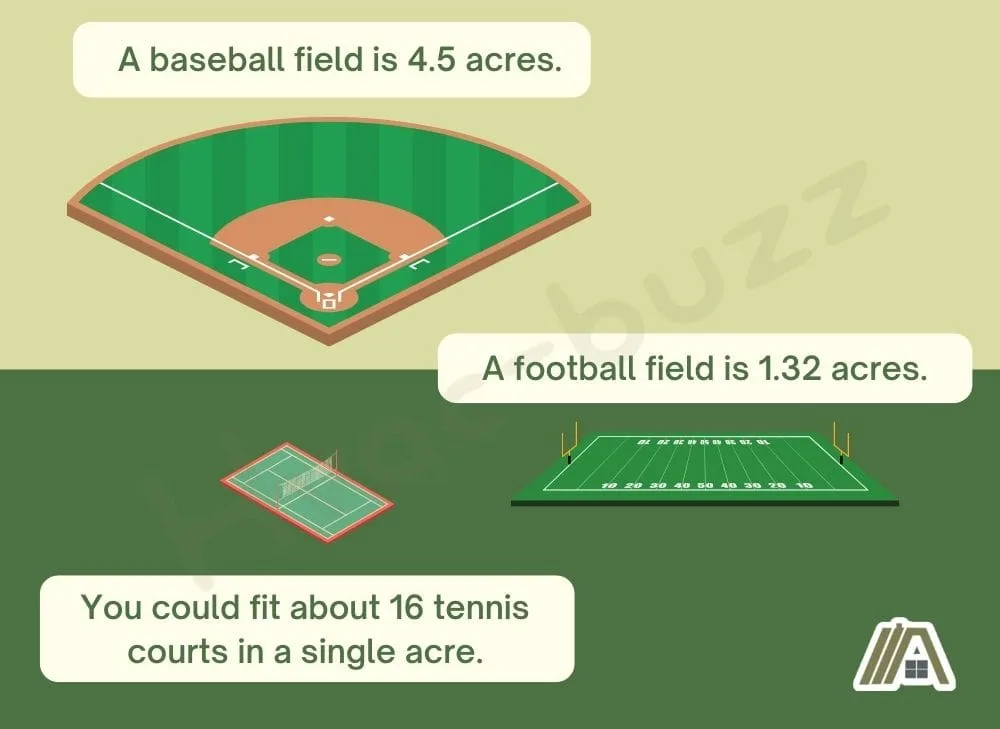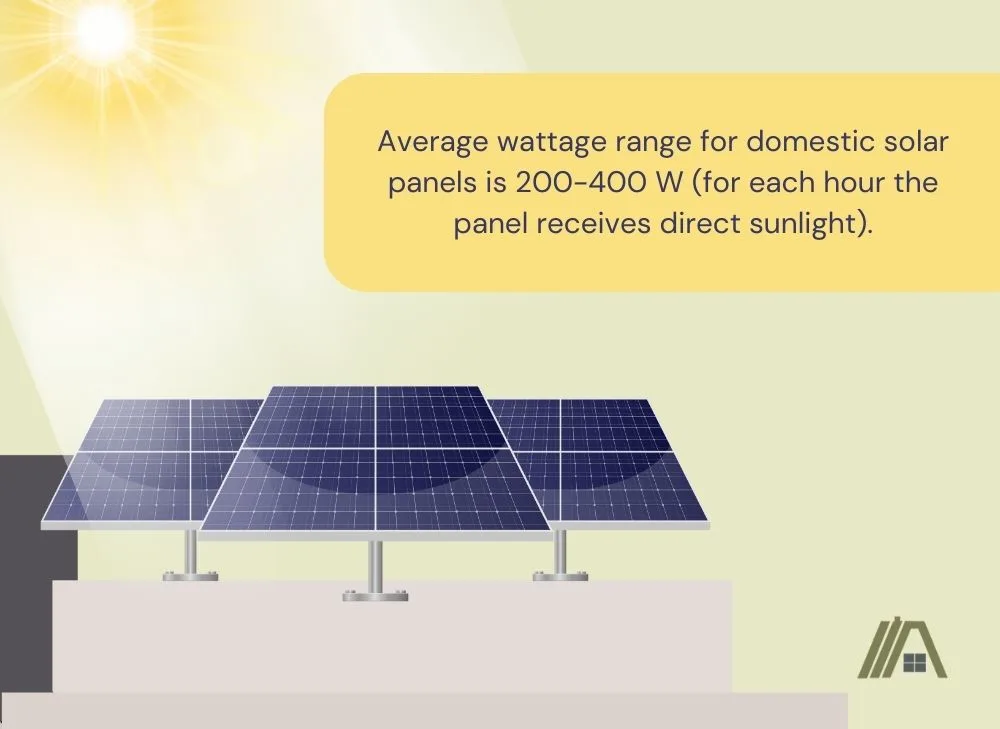So you’re looking to go off the grid a little, saving on energy costs and working towards a greener future? Kudos to you. There are more and more homeowners each year that are making these greener choices. Solar energy is one of the most popular renewable energy sources one can obtain; over 2 million households in the US have installed solar systems.
However, before you start this new green chapter, it’s important to know what you need and how much energy you can expect in return from your one acre of land.

On average, 2,227.5 kWh of solar energy can be produced on one acre of land per day. Average US homes use 30 kWh of electricity.
How Big is An Acre?
An acre is a unit of area that is used specifically to measure a piece of land. In terms of how big an acre is, one acre measures out to 0.0016 square miles or 43,560 square feet. If you prefer the metric system, one acre is 4,046.86 square meters.
Perhaps, like me, square miles are just as mysterious to you as one acre. Let’s look at some visual comparisons of how big one acre is:
- A football field is 1.32 acres.
- A baseball field is 4.5 acres.
- You could fit about 16 tennis courts in a single acre.

What Is Needed to Harness Solar Energy?
It’s not just about how many panels you can fit on one acre of land. Some space also has to be given to the accessories and the parts that convert the solar energy to usable energy. In addition to these, you need room to move around between the panels to set them up and do maintenance.
Solar panels
Three different types of solar panels exist, each differing in cost and efficiency.
- Monocrystalline panels are blue/black tinted, more efficient (15-20%), and most expensive.
- Polycrystalline panels are more affordable, less efficient (13-16%), and are lighter blue.
- Thin-film panels, however, often have even lower efficiencies (7-18%) than the crystalline contenders and degrade more readily. But they are cheaper, flexible, and very portable (lightweight).
Inverters and Batteries
Inverters convert the direct current received from the solar panels into alternating current (generally used by most home appliances).
During this conversion, some of the energy is lost, making the amount of usable solar energy less than the amount of total energy captured from the sun. This is interpreted as the solar panel’s efficiency and is given as a percentage.
There are two types of inverters, namely, string inverters and microinverters. String inverts connect all your panels to your home as a single unit, which can be tricky if one panel is faulty and affects the total solar output. Microinverters don’t have this problem as they connect to each panel separately, maximizing output.
You will also need solar batteries to store this energy until you use it.
Racking
Racking systems secure the solar panels in place, and because you are looking at installing panels on land (as opposed to on a roof), the best option would be to look at ground-mounted solar panels.
This aluminum racking is secured into the ground through concrete footings. Some have tracking systems installed that follow the sun to obtain as much sunlight as possible throughout the day, increasing efficiency.
If you have tracking systems, they will likely need more space to ensure that there are no collisions when moving.
Do You Need a Permit?
If you were to install solar panels on the roof of your home, then you would most definitely require a building permit. However, if you are basically going off the grid by adding solar panels to an acre of land, it’s unlikely that you would require a permit.
There are some regulations set out by the National Electric Code that govern the installation and usage of solar energy. Usually, professionals that install solar panels should follow these building regulations.
Average Size of a Solar Panel
On average, domestic solar panels are 65″ in length and 40″ in width (2,600 square inches = 18.06 square feet). As there are 43,560 square feet in one acre, that equates to about 2,400 solar panels.
However, giving room for all the accessories and space to move, you are looking more at a maximum of 1,500-1,800 panels
Energy Generated On 1 Acre
Domestic solar panels have about 60 solar cells per panel compared to commercial solar panels, which have about 72 solar cells per panel. The number of cells correlates with the size of the solar panel (commercial panels are larger).
In general, it is very difficult to predict the exact amount of energy produced by a solar panel because of all the things that can affect the amount of energy generated per panel:
- Material (efficiency)
- Location of panels
- Angle of panels
- Geographical location
- Season
Panels are sold as having x wattage. This is useable wattage and typically means per hour. So, you can get a 120 W panel or a 275 W panel, for example. But the average wattage range for domestic solar panels is 200-400 W (for each hour the panel receives direct sunlight).

The average hours of sunlight (direct sunlight that can be used by solar panels) is about 4-5 hours per day.
With this information and the number of panels that can fit on one acre, we can have a guess at how much usable solar power can be generated on one acre of land.
Let’s take the averages of the averages:
- 1,650 panels
- 300 W
- 4.5 hours of direct sunlight
If one panel produces 300 W per hour of direct sunlight, then in one day, it can produce 1,350 Wh. If you have 1,650 panels, your daily production would be 2,227,500 Wh. That is 2,227.5 kWh in a single day.
Can This Energy Run a House?
On average, the amount of energy used per day by a standard American household is 30 kWh. Now, as we have estimated above, one acre will produce a whopping 2,227.5 kWh per day.
I think it is safe to say that the energy produced, on a good day, and taking the various factors into consideration, will be able to run a standard American home comfortably. In fact, you would only really need 1.4-3% of that acre to power the house.
Again, it is very difficult to get a consistent average every time as there are multiple factors that are also inconsistent.
Energy usage may depend on the season, which can lead to more appliances, like heaters, being used more often. It may also depend on the number of people in a household and what type of material was used to construct the house; some materials keep homes insulated more efficiently than others.
How Much Will It Cost?
This type of system will cost you a pretty penny to set up, but it may be worth it in the long run.
Initially, setting up a ground-mounted solar system can cost you about $400,000 – $500,000. But fewer panels will lower the price.
Since the amount of energy generated on one acre of land filled with solar panels is well over the amount of power used, you can reduce the installation costs by down-scaling the number of panels without hindering your dreams of a completely solar powered home.
The maintenance costs may differ from home to home. It depends on the type of solar panel you have and the terrain of your acre of land. On average you may have to spend up to $1,200 for solar panel maintenance and repair, and up to $150 for cleaning and annual inspections.
Sources
https://www.bobvila.com/articles/cost-of-solar-panels/
https://www.deegesolar.co.uk/types_of_solar_panels/
https://www.prospectsolar.com/solar-101/solar-equipment/
https://news.energysage.com/solar-energy-equipment-needed-to-go-solar/
https://news.energysage.com/ground-mounted-solar-panels-top-3-things-you-need-to-know/
https://news.energysage.com/average-solar-panel-size-weight/
https://usa-gce.com/do-i-need-permit-to-install-solar-panels-in-california/
https://www.greenlancer.com/post/need-for-off-grid-solar-permit
https://www.renewableenergyhub.co.uk/blog/top-5-solar-farm-land-requirements/
https://news.energysage.com/what-is-the-power-output-of-a-solar-panel/
https://www.quora.com/In-1-acre-of-land-how-much-solar-power-can-be-generated
https://blog.constellation.com/2021/02/25/average-home-power-usage/
https://us.sunpower.com/how-many-solar-panels-do-you-need-panel-size-and-output-factors


